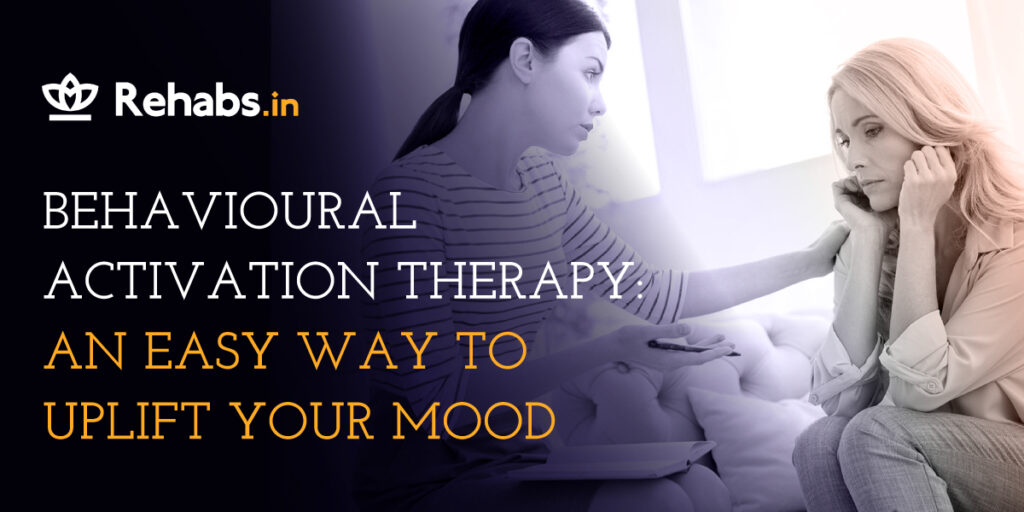Behavioural activation therapy: An easy way to uplift your mood

Let’s picture an individual with depression wants to improve their mood by engaging in more physical activity. The therapist and individual might start by identifying a larger goal, such as running a 5K race. However, the individual may feel overwhelmed by the prospect of running a 5K race, and may not know where to start.
To help the individual achieve their goal, the therapist might break down the goal into smaller, more manageable tasks. The therapist might suggest that the individual start by going for a 10-minute walk three times a week. This is a smaller, more manageable task that can help the individual build confidence and motivation.
Once the individual has successfully completed the 10-minute walk three times a week for a few weeks, the therapist might suggest increasing the duration of the walk to 15 or 20 minutes. This is another small, manageable task that helps the individual continue to build momentum towards their larger goal.
Over time, the therapist and individual might continue to increase the duration and frequency of the walks until the individual feels confident enough to start training for the 5K race. By breaking down the larger goal into smaller, more manageable tasks, the individual is able to build momentum, increase confidence, and achieve their goal.
This is one of the techniques used in Behavioural Activation Therapy.
What is Behavioural Activation Therapy?
Behavioural Activation Therapy (BAT) is a type of psychotherapy that focuses on helping people to overcome depression and improve their mood by increasing their engagement in positive and meaningful activities. This therapy helps individuals to identify and modify negative patterns of behavior that contribute to their depression and encourages them to engage in activities that bring them pleasure and a sense of accomplishment. The goal of BAT is to help individuals feel more motivated, energized, and connected to others, leading to a more fulfilling and satisfying life.
One example of a behavioural activation technique is called “activity scheduling”. This involves identifying and scheduling specific activities that the individual enjoys or finds meaningful, even if they don’t feel like doing them at first. The therapist works with the individual to develop a list of activities, which can be anything from exercise to spending time with friends to pursuing a hobby.
The individual then schedules these activities into their daily or weekly routine, and gradually increases the amount of time spent on these activities over time. By engaging in these positive activities, the individual is able to increase positive experiences and build a sense of mastery, which can help to improve their mood and overall well-being.
Features of BAT
Focuses on the present: Unlike other therapies that may focus on exploring the past or unconscious thoughts, BAT focuses on the present and practical strategies to improve mood. This can be especially helpful for individuals who may feel stuck or overwhelmed by their depression.
Evidence-based: BAT has been extensively researched and has shown to be an effective treatment for depression. Studies have found that BAT is at least as effective as other types of therapy, such as Cognitive Behavioural Therapy (CBT) and medication.
Easily adaptable: BAT can be adapted to fit the needs of each individual. Therapists work collaboratively with their clients to identify specific goals and develop a plan that works for them. This means that BAT can be customized to address the unique challenges and strengths of each person.
Emphasizes personal values and goals: BAT helps individuals identify their personal values and goals, and encourages them to engage in activities that align with those values. This helps individuals to feel more connected to their sense of purpose, which can be especially important for individuals struggling with depression.
Holistic approach: BAT takes a holistic approach to mental health, recognizing that depression is not just a biological or psychological issue, but also impacted by social and environmental factors. This means that BAT looks at the individual’s overall well-being, and helps them to address any challenges in their life that may be contributing to their depression.
Steps in BAT
- Assessment: The therapist will conduct an initial assessment to better understand the individual’s symptoms, their history, and any factors that may be contributing to their depression. This may include a review of their medical history, a mental health assessment, and a discussion of their current lifestyle and social supports.
- Goal Setting: The therapist will work with the individual to identify specific goals that they want to achieve through therapy. This may include goals related to mood, behaviour, relationships, or overall well-being.
- Activity Planning: The therapist will help the individual to identify specific activities that align with their goals and values, and that they enjoy or find meaningful. These activities may be simple, such as going for a walk or listening to music, or more complex, such as pursuing a hobby or joining a social group.
- Activity Monitoring: The individual will be asked to track their engagement in these activities, and to monitor how they feel before and after each activity. This helps to identify patterns of behaviour that may be contributing to their depression, and to identify activities that are particularly effective in improving mood.
- Behavioural Experiments: The therapist may encourage the individual to engage in “behavioural experiments” to test out the effectiveness of different activities or behaviours. This involves trying out new behaviours or activities and monitoring the impact on mood and overall well-being.
- Problem Solving: The therapist will work with the individual to address any challenges or obstacles that may be preventing them from engaging in positive activities. This may involve problem-solving strategies or practical solutions to address any barriers to behaviour change.
- Relapse Prevention: Finally, the therapist will work with the individual to develop strategies for maintaining their progress and preventing relapse. This may involve developing coping skills, identifying early warning signs of depression, and creating a plan for managing any setbacks that may occur.
Techniques in BAT
- Activity Scheduling: This technique involves identifying and scheduling specific activities that align with the individual’s goals and values. The therapist helps the individual to create a daily or weekly schedule that includes enjoyable and meaningful activities, such as exercise, hobbies, or socializing.
- Graded Task Assignment: This technique involves breaking down larger goals into smaller, more manageable tasks. The therapist helps the individual to identify specific steps they can take to achieve their goals, and encourages them to take gradual, incremental steps towards their larger goals.
- Behavioural Experiments: This technique involves trying out new behaviours or activities to test their impact on mood and overall well-being. The therapist encourages the individual to try out new activities or behaviours, and to monitor their mood and any changes in their thoughts or behaviours.
- Problem Solving: This technique involves identifying and addressing any obstacles or challenges that may be preventing the individual from engaging in positive behaviours. The therapist helps the individual to identify solutions to any problems or challenges that arise, and encourages them to develop problem-solving skills that they can use in other areas of their life.
- Social Skills Training: This technique involves developing and enhancing social skills, such as communication, assertiveness, and conflict resolution. The therapist helps the individual to identify areas where they may struggle with social interactions, and provides guidance and support to help them develop more effective social skills.
- Relaxation Training: This technique involves teaching the individual techniques for managing stress and anxiety, such as deep breathing, progressive muscle relaxation, or mindfulness meditation. The therapist helps the individual to develop a relaxation routine that they can use to manage stress and anxiety in their daily life.
Behavioural Activation Therapy for Addiction
BAT can be an effective treatment approach for individuals with substance use disorders, particularly when used in combination with other treatments, such as medication-assisted treatment or cognitive-behavioural therapy. Activity scheduling and graded task assignment can be particularly helpful in helping individuals develop healthy habits and engage in positive behaviours.
If you or someone you know is suffering from substance use disorders or other mental health problems, BAT could be a good option for you. You can browse a list of mental health treatment centers across India here.
Sources:
Uphoff, E., Ekers, D., Dawson, S., Richards, D., & Churchill, R. (2019b). Behavioural activation therapies for depression in adults. The Cochrane Library. https://doi.org/10.1002/14651858.cd013305
Villines, Z. (2021, October 25). What is behavioral activation? https://www.medicalnewstoday.com/articles/behavioral-activation














